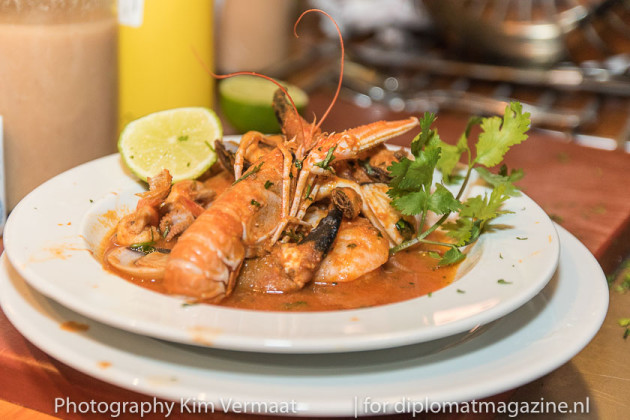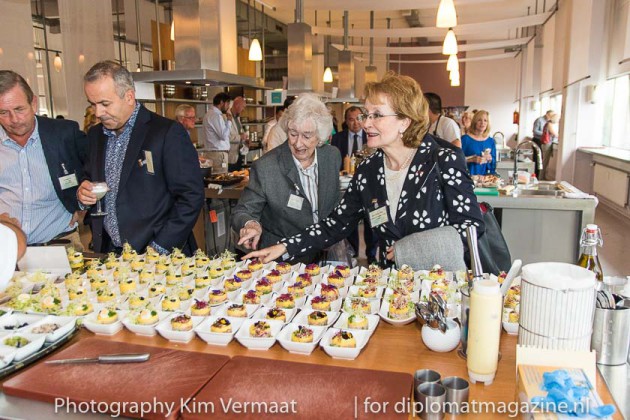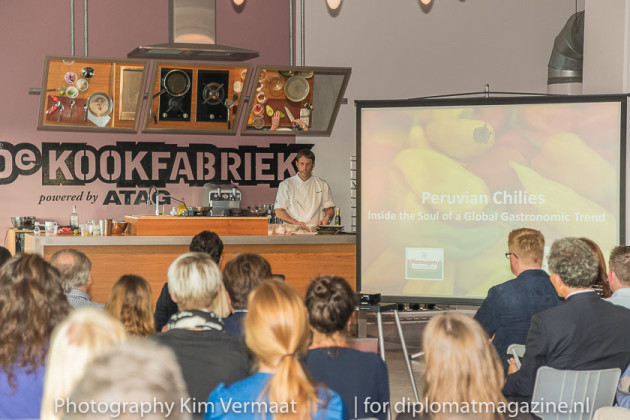Pictured H.E. Carlos Herrera, Ambassador of Peru.
By Ellen Brager-Michiels.
The Embassy of Peru chose Prinsjesdag to organize a culinary workshop with the Peruvian pepper – or ají – as the main ingredient. As H.E. Ambassador Carlos Herrera pointed out in his welcome words, it is not possible to condense in one single night all the different cuisines from Peru.
Very diverse flavors and ingredients are native to the Andean mountains, the Amazon jungle and the coastal areas, influenced by 90 different microclimates and many rich and ancient cultures. Did you know that more than 3,000 varieties of the potato and 55 types of corn are grown in Peru? With such abundance of choice, some focus was required and the spot light was put on the Peruvian ají.
For additional Kim Vermaat’s pictures, please open the following link: https://www.flickr.com/photos/121611753@N07/albums/72157674393406275

The event took place in the beautiful and professionally equipped facilities of De Kookfabriek in The Hague. Among the many guests we noticed not only Ambassadors and other diplomats, but also professionals and students from the culinary sector.
At the entrance several importers had put a variety of Peruvian products on display for the arriving guests to check out while enjoying a traditional pisco sour welcome drink.

Ambassador Herrera and Jeroen van der Graf of the company Verstegen, specialist in spices & sauces and co-sponsor of the event, opened the evening with praise for the Peruvian cuisine and its growing worldwide reputation as one of the finest.
Then Chef James Berckemeyer, owner of restaurant Cosme in Lima, went on with the first cooking demonstration. He explained how leche de tigre is made and how it can be used as a starting point to create a variety of ceviches. With skill and passion he lead us through the various preparations while giving away a few insider secrets.

We learned, among other things, that the ingredients for the leche de tigre (see insert) must be blended with short impulses, just to get the flavor out of them but not turn them into mush. That the ají must be boiled three times, each time starting with cold water and renewing the water when it has come to a boil. That soaking sliced onion in cold water makes it crisp and softens the taste. “Leche de tigre”, he said jokingly, “literally means ‘tiger milk’, supposedly because if you drink some of it when you have a hangover it makes you feel like a tiger again!”
Nevertheless, he preferred to use it that evening to create four unique ceviches: a traditional one, one inspired by the Chinese cuisine, one with tuna, and one with fried instead of raw fish. His main advice was to start with a tried-and-true base, be creative and look for unusual variations on a common theme.

With their appetites now sufficiently aroused, the guests went on to the cooking stations where several Peruvian restaurants from near and as far as Antwerp had prepared a feast for the eyes and palate.
Each table tried to outdo the others with the most beautiful display of colorful ceviches, tiraditos, causas, ají relleno, lomo saltado, mermelada de rocotto and other staples from the Peruvian cuisine. In the meantime at the bar the pisco sours became more and more creative as well, with a touch of Grand Marnier or Blue Curaçao or a special high-end soda.

To end the evening Chef Berckemeyer returned to the stage with a preparation of limón de convento, made of a very thin lime skin, vacuum boiled and stuffed with a mixture of dulce de leche, whipping cream, almond milk and other ingredients. Then the winners of the evening’s raffle were announced and four lucky guests received a Peruvian cook book.
Last but not least a delicious desert with layers of chocolate and lúcuma, prepared by Chef James Berckemeyer was passed around; also Alberto Lara, the Embassy’s own chefs, presented his best recipes . As the guests were leaving, happy and satisfied, they received a goody-bag with business cards of the participating restaurants and entrepreneurs, a mini cook book issued by Verstegen and inspired by the spices they import, as well as a small bottle of pisco, a little jar of ají and a quinoa brownie.
The evening was a true tribute to the Peruvian cuisine and an affirmation that its high rank in the global gastronomy is a well-earned title.



